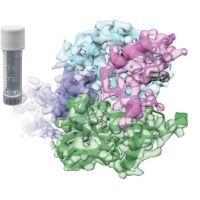Specification
| Description | Recombinant protein from the full-length sequence of Homo sapiens aldo-keto reductase family 1 member A1 (AKR1A1), transcript variant 1 (NM_006066). |
| Organism | Homo sapiens (Human) |
| Expression Host | Human Cells |
| Tag Info | His or DYKDDDDK. Please contact us if you need further information or require specific designed tag. |
| Purity | Greater than 90% by SDS-PAGE gel |
| Uniprot ID | P14550 |
| Entry Name | AK1A1_HUMAN |
| Gene Names | AKR1A1 ALDR1 ALR |
| Alternative Gene Names | ALDR1 ALR |
| Alternative Protein Names | Aldo-keto reductase family 1 member A1 (EC 1.1.1.2) (EC 1.1.1.372) (EC 1.1.1.54) (Alcohol dehydrogenase [NADP(+)]) (Aldehyde reductase) (Glucuronate reductase) (EC 1.1.1.19) (Glucuronolactone reductase) (EC 1.1.1.20) |
| Application | Antigens, Western, ELISA and other in vitro binding or in vivo functional assays, and protein-protein interaction studies; For research & development use only! |
| Buffer | Purified protein formulated in a sterile solution of PBS buffer, pH7.2, without any preservatives |
| Endotoxin | Endotoxin level is < 0.1 ng/µg of protein (<1EU /µg) |
| Length | 325 |
| Molecular Weight(Da) | 36573 |
| Protein Sequence | (The sequence of expressed protein may have some variation from the sequence shown below. Please contact us for the exact sequence.) MAASCVLLHTGQKMPLIGLGTWKSEPGQVKAAVKYALSVGYRHIDCAAIYGNEPEIGEALKEDVGPGKAVPREELFVTSKLWNTKHHPEDVEPALRKTLADLQLEYLDLYLMHWPYAFERGDNPFPKNADGTICYDSTHYKETWKALEALVAKGLVQALGLSNFNSRQIDDILSVASVRPAVLQVECHPYLAQNELIAHCQARGLEVTAYSPLGSSDRAWRDPDEPVLLEEPVVLALAEKYGRSPAQILLRWQVQRKVICIPKSITPSRILQNIKVFDFTFSPEEMKQLNALNKNWRYIVPMLTVDGKRVPRDAGHPLYPFNDPY |
Background
| Function | FUNCTION: Catalyzes the NADPH-dependent reduction of a wide variety of carbonyl-containing compounds to their corresponding alcohols. Displays enzymatic activity towards endogenous metabolites such as aromatic and aliphatic aldehydes, ketones, monosaccharides and bile acids, with a preference for negatively charged substrates, such as glucuronate and succinic semialdehyde (PubMed:10510318). Functions as a detoxifiying enzyme by reducing a range of toxic aldehydes. Reduces methylglyoxal and 3-deoxyglucosone, which are present at elevated levels under hyperglycemic conditions and are cytotoxic. Involved also in the detoxification of lipid-derived aldehydes like acrolein (By similarity). Plays a role in the activation of procarcinogens, such as polycyclic aromatic hydrocarbon trans-dihydrodiols, and in the metabolism of various xenobiotics and drugs, including the anthracyclines doxorubicin (DOX) and daunorubicin (DAUN) (PubMed:18276838, PubMed:11306097). Displays no reductase activity towards retinoids (By similarity). {ECO:0000250|UniProtKB:P50578, ECO:0000250|UniProtKB:P51635, ECO:0000269|PubMed:10510318, ECO:0000269|PubMed:11306097, ECO:0000269|PubMed:18276838}. |
| Pathway | |
| Protein Families | Aldo/keto reductase family |
| Tissue Specificity | Widely expressed. Highly expressed in kidney, salivary gland and liver. Detected in trachea, stomach, brain, lung, prostate, placenta, mammary gland, small intestine and lung. {ECO:0000269|PubMed:10486210, ECO:0000269|PubMed:10510318, ECO:0000269|PubMed:11306097}. |
QC Data
| Note | Please contact us for QC Data |
| Product Image (Reference Only) |  |

